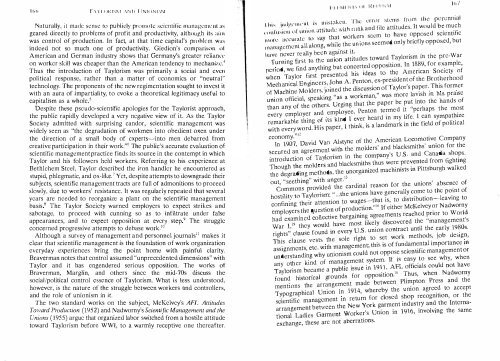CONTENTS - ouroboros ponderosa
CONTENTS - ouroboros ponderosa
CONTENTS - ouroboros ponderosa
Create successful ePaper yourself
Turn your PDF publications into a flip-book with our unique Google optimized e-Paper software.
11,1,<br />
1'..\ '1 1,( Jln'>rYI ,\NI) l iN!! )NI.';l\1<br />
Naturally, it made sense to publicly proillutc scientific lIlanagclIll' lIl as<br />
geared directly to problems of profit and productivity, alth()lJh its ailll<br />
was control of production. In fact, at that time capital's prohkm was<br />
indced not so much one of productivity. Giedion's comparison 01<br />
American and G erman industry shows that Germany's greatcr reliance<br />
on workcr skill was cheaper than the American tendency to mechanize."<br />
Thus the introduction of Taylorism was primarily a social and even<br />
political response, rathcr than a matter of economics or " neutral"<br />
technology. The proponents of the new rcgimentation sought to invcst it<br />
with an aura of impartiality, to cvoke a theoretical legitimacy useful to<br />
capitalism as a wholc .'<br />
Despite these pseudo-scientific apologies for the Taylorist approach,<br />
the public rapidly developed a vcry negative view of it. As the Taylor<br />
Society admitted with surprising candor, scientific managcmcnt was<br />
widely seen as "the degradation of workmen into obedient oxen under<br />
the direction of a small body of cxperts-into men debarred from<br />
creative participation in their work."6 The public'S accurate evaluation of<br />
scientific management practice finds its source in the contempt in which<br />
Taylor and his followers held workers. Referring to his expcrience at<br />
Bdhlehem Steel, Taylor dcscribed the iron handler he encountered as<br />
stupid, phlegmatic, and ox-like 7 Yet, despite attempts to downgradc their<br />
subjects, scientific management tracts are full of admonitions to proceed<br />
slowly, due to workers' resistance. It was regularly repeated that several<br />
years are needed to reorganize a plant on the scientific management<br />
basis ' The Taylor Society warned employcrs to expect strikes and<br />
sabotage, to proceed with cunning so as to infiltrate under false<br />
appearances, and to expect opposition at every step .' The struggle<br />
concerned progressive attempts to debase work.JO<br />
Although a survey of management and personnel journals" makes it<br />
clear that scientific managemcnt is the foundation of work organization<br />
evcryday experiences bring the point home with painful clarity.<br />
Braverman notes that control assumed "unprecedented dimensions" with<br />
Taylor and it has engendered serious opposition. The works of<br />
Braverman, Marglin, and others since the mid-70s discuss the<br />
social/political control cssence of Taylorism. What is less understood,<br />
however, is the nature of the struggle between workers and controllers,<br />
and the role of unionism in it .<br />
The two standard works on the subject, McKelvcy's AFI. Attitudes<br />
Toward Prodllction (1952) and Nadworny's Scientific Management and the<br />
Unions (1955) argue that organized labor switched from a hostile attitude<br />
toward Taylorism before WWI, to a warmly receptive one thereafter.<br />
I'his .iudgt·IH·II.1 IS IHS\.Il:.I<br />
. . . . .. Till' rrnr stems fro ill lhe perennial<br />
l.<br />
.<br />
ronfllsion 01 lInt{)1l attitude. With rmk . . ,.<br />
ll1






